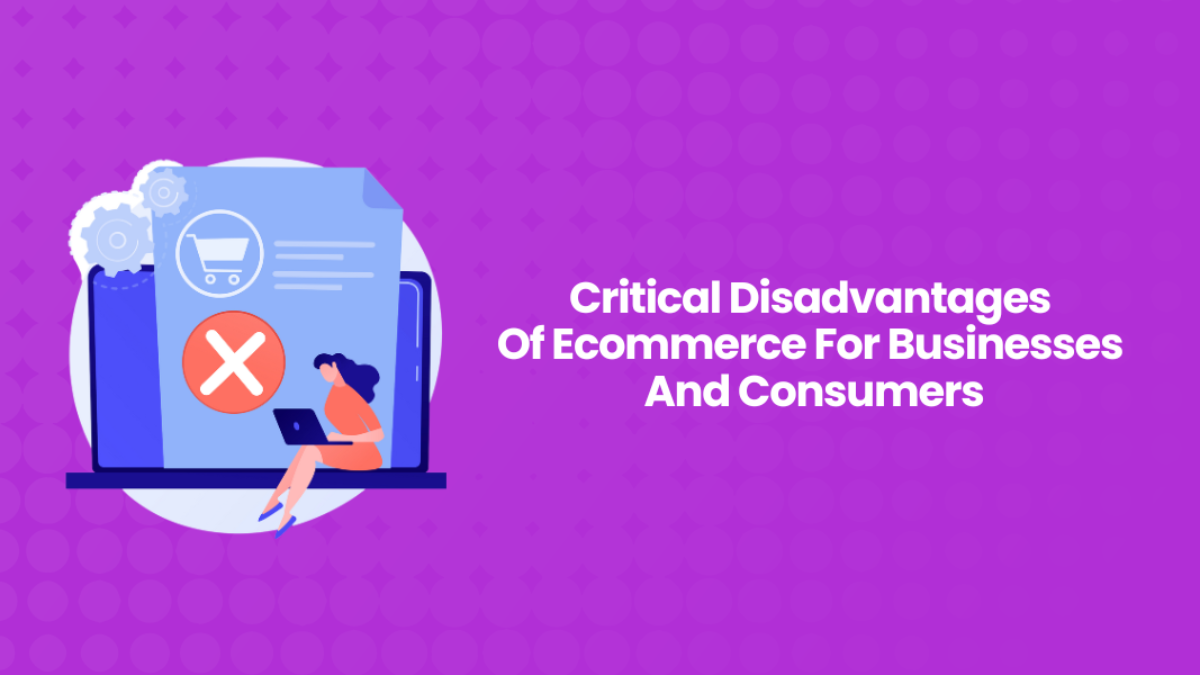Ecommerce has undeniably transformed the shopping experience, offering unparalleled convenience and accessibility. With the ability to browse products, compare prices, and have items delivered directly to your doorstep, it’s no wonder that online shopping has become a dominant force in the retail industry. However, while the advantages of ecommerce are well-documented, it’s equally important to address its critical disadvantages. Understanding these drawbacks can help both consumers and businesses navigate the digital marketplace more effectively. In this blog, we’ll explore the key disadvantages of ecommerce and offer insights on how to mitigate these challenges.
Critical Disadvantages of Ecommerce
Security and Privacy Risks
- Concern: Online shopping requires personal information (names, addresses, credit card details), making it vulnerable to data breaches, identity theft, and fraud.
- Impact on Consumers: Severe consequences include financial losses and lengthy legal battles.
- Impact on Businesses: Data breaches can lead to substantial financial losses, legal issues, and reputational damage.
Mitigation Strategies:
- Consumers should shop on secure websites and use fraud-protected payment methods.
- Businesses need to invest in robust security measures and stay updated on cybersecurity practices.
Lack of Personal Interaction
- Concern: Ecommerce lacks the personal touch of physical stores where customers can engage with sales associates and receive tailored recommendations.
- Impact on Consumers: Difficulties arise for products requiring hands-on evaluation, such as clothing and electronics.
- Impact on Businesses: Challenges in providing the same level of customer service and building relationships.
Mitigation Strategies:
- Offer detailed product descriptions, virtual try-ons, live chat support, and comprehensive FAQs.
Shipping Costs and Delays
- Concern: Shipping costs can be high, and delays can impact customer satisfaction.
- Impact on Consumers: Increased shipping costs and delays can reduce the perceived value of online shopping.
- Impact on Businesses: Complex and costly logistics management.
Mitigation Strategies:
- Consumers should be aware of shipping policies and costs.
- Businesses should optimise logistics, offer transparent shipping options, and invest in efficient supply chain management.
Limited Product Experience
- Concern: Inability to physically inspect products before purchase can lead to dissatisfaction.
- Impact on Consumers: Risk of receiving products that do not meet expectations, leading to higher return rates.
- Impact on Businesses: High return rates due to inaccurate product representations can be costly and challenging.
Mitigation Strategies:
- Provide high-quality images, detailed product descriptions, and customer reviews.
- Implement flexible return policies.
Increased Competition and Market Saturation
- Concern: Lower barriers to entry have increased competition and market saturation.
- Impact on Consumers: More choices and better deals.
- Impact on Businesses: Requires effective marketing and strong value propositions. Market saturation can lead to price wars and reduced profit margins.
Mitigation Strategies:
- Focus on unique selling points, invest in targeted marketing, and build a strong brand identity.
Environmental Impact
- Concern: Packaging waste and carbon footprint associated with shipping.
- Impact on Consumers: Awareness of environmental impact can influence purchasing decisions.
- Impact on Businesses: Packaging waste and carbon footprint affect sustainability efforts.
Mitigation Strategies:
- Consumers can support eco-friendly businesses.
- Retailers should adopt sustainable packaging, optimise shipping practices, and promote environmentally responsible policies.
Challenges in Building Customer Loyalty
- Concern: Difficulty in retaining customers due to ease of price comparison and switching between retailers.
- Impact on Consumers: Abundance of choices and ease of comparison dilute brand loyalty.
- Impact on Businesses: Requires exceptional experiences and personal connections beyond competitive pricing.
Mitigation Strategies:
Focus on personalised marketing, loyalty programs, and exceptional customer service.
Dependence on Technology
- Concern: Reliance on technology can lead to issues such as website downtime and payment processing errors.
- Impact on Consumers: Technical problems can affect the convenience and enjoyment of online shopping.
- Impact on Businesses: Requires ongoing investment in technology and infrastructure.
Mitigation Strategies:
- Consumers should choose reliable platforms with good technical support.
- Businesses need to maintain robust technical systems, invest in regular updates, and ensure website resilience.
Conclusion
Understanding the critical disadvantages ecommerceis vital for making informed choices in the digital marketplace. Challenges such as security risks, lack of personal interaction, environmental concerns, and market saturation can have substantial effects on both consumers and businesses. Addressing these issues will help you navigate ecommerce more effectively, balancing the convenience it offers with an awareness of its potential drawbacks. Whether you’re an online shopper or an ecommerce manager, recognizing and addressing these disadvantages will lead to more informed and effective decision-making.

Leave a Comment